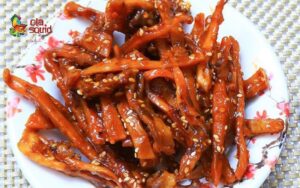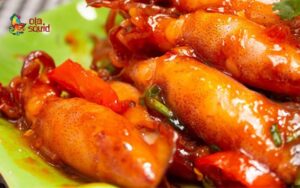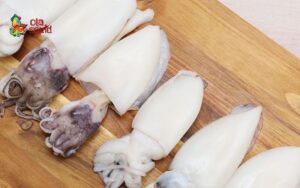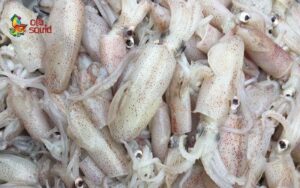Squid is one of the most popular and favored seafoods in Vietnam, thanks to its natural sweetness and pleasant chewiness. With its long, slender body and crisp, sweet white flesh, squid is not only easy to prepare but also offers high nutritional value. So, what exactly is squid, how can you identify it, and how should you choose it to ensure a delicious and satisfying dish? Let’s dive into this article to answer all your questions!
What is Squid?
Characteristics of Squid
Squid is a type of soft-bodied marine seafood, named for its characteristic long, tube-like shape. This species of squid has a cylindrical body, a thin tail with fins extending from the middle to the end, forming a unique diamond shape.

Squid has 8 short tentacles and 2 long arms, with skin often adorned with prominent pink spots and large, clear eyes. In addition to its ink sac used for defense, squid is also notable for its sweet, slightly chewy flesh and distinctive flavor, making it highly popular in many rustic and high-end dishes alike.
Classification of Squid
Depending on size and preservation method, squid can be classified as follows:
- Live Fresh Squid: Caught and immediately kept on ice on the boat, preserving its peak freshness.
- Frozen Squid: Pre-processed and frozen, convenient for long-term storage.
- Sun-Dried Squid (One-Day Dried): Dried in the sun once, lightly dried on the outside but retaining its sweet flesh inside.
- Dried Squid: Fully dried, often used for grilling as a snack or in salads.
Distinguishing Squid from Cuttlefish
Squid and cuttlefish are both nutritious seafoods frequently featured in Vietnamese cuisine. However, each type has a different shape, flesh texture, and flavor, making them suitable for different cooking methods. Here is a detailed comparison to help you easily distinguish between them:
| Criteria | Squid | Cuttlefish |
| Shape | Long, tube-like body, 8 short tentacles and 2 long arms | Round, oval body, larger in size |
| Color | Skin with iridescent spots, shimmering with rainbow hues | Body with distinct brown and white horizontal stripes |
| Cuttlebone | Thin, small, long cuttlebone located along the spine | Large, thick cuttlebone hidden under the striped skin |
| Average Weight | 300 – 800g/piece | 1 – 3kg/piece |
| Flesh | Soft, slightly chewy, and delicately sweet | Thicker, crisper flesh, milder flavor |
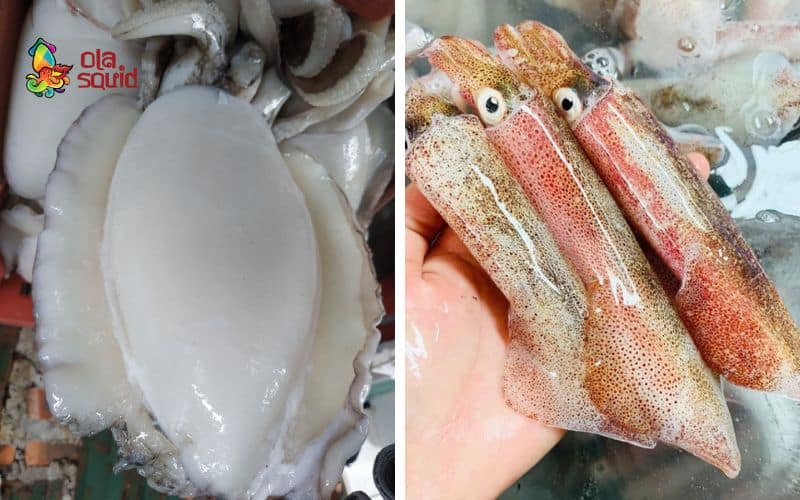
How to Choose Fresh, Delicious Squid
To create delicious dishes that retain their natural sweetness, choosing fresh squid is crucial. Here are some simple tips to help you easily identify quality squid:
- Observe the skin color: Fresh squid will have a distinct dark brown skin, contrasted with a bright white, smooth body. Avoid squid with dull or grayish colors.
- Look at the eyes: Fresh squid have clear, bright eyes, with the pupil visible. Cloudy or milky-white eyes indicate the squid is old or of poor quality.
- Check for elasticity: Gently press the squid’s body with your finger. If the flesh is firm and quickly springs back, the squid is fresh. Conversely, if the flesh is soft and mushy, it’s a sign the squid is old.
- Examine the tentacles: Fresh squid usually have all 8 tentacles and 2 long arms firmly attached to the body. If the tentacles are missing, detached, or slimy, the squid may not be fresh.
How to Prepare Squid
To preserve the fresh taste of squid during cooking, proper preparation is essential. Here are the basic steps for effectively cleaning squid:
- Rinse thoroughly: Place the squid under cold running water and rinse gently to remove any sand, dirt, and slime from the outside of the body.
- Separate the head and innards: Gently pull the head away from the body, removing the ink sac if not needed. Be careful not to rupture the ink sac, which can stain the flesh.
- Remove skin (if desired): You can peel off the thin outer skin if you prefer a brighter white color for your cooked squid.
- Score the body: Use a knife to make shallow diagonal or crosshatch cuts on the body. This helps the squid absorb marinades better and prevents it from curling up during cooking.
- De-odorize: Soak the squid in a little white wine or crushed ginger for a few minutes, then rinse with clean water. Afterwards, ensure the squid is well-drained before marinating and cooking. This helps maintain its fresh flavor and prevents the dish from becoming watery.
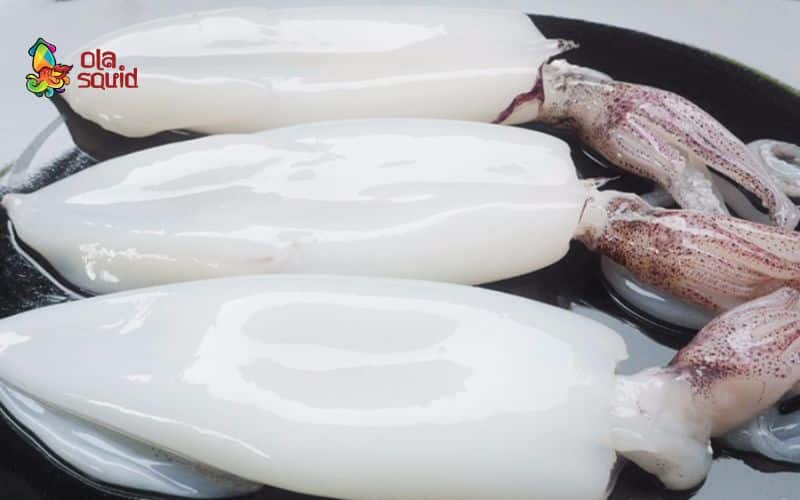
What Delicious Dishes Can Be Made with Squid?
Squid is a fantastic ingredient for many delicious dishes. Here are 3 popular and easy-to-make dishes you should try:
Grilled Squid
Without needing to be elaborate, grilled squid is a dish that is both easy to make and appealing due to the natural flavor of the squid, combined with a hint of spice from chili sauce or simply salt and pepper. After being cleaned and well-marinated, squid grilled over charcoal releases an irresistible aroma. The outside of the squid is lightly charred, while the inside remains tender and sweet. Dipped in chili sauce or a ginger fish sauce, it’s enough to tantalize your taste buds.
Squid Stuffed with Minced Meat in Tamarind Sauce
Squid stuffed with minced meat in tamarind sauce is a delicate blend of the chewy squid exterior and the soft, flavorful filling inside made from minced meat, mushrooms, and spices. When combined with a sweet and sour tamarind sauce, the dish offers a rich and novel flavor that is very stimulating to the palate. Besides its delicious taste, this dish is also visually appealing, making it suitable for family meals or entertaining guests, guaranteed to impress everyone who tries it.

Steamed Squid
Steamed squid is an ideal choice for those who prefer a light yet flavorful taste of the sea. The squid is steamed with fresh ginger and green onions, which helps to remove any slight fishiness and enhance its pleasant aroma. When cooked, the squid retains its natural crispness, with a sweet, tender flesh that is neither dry nor tough. This is an excellent option for both everyday family meals and more formal banquets.
Current Squid Prices
Squid prices in the current market vary depending on the size and freshness of the product. Larger, fresher squid will command higher prices. Here are the reference prices:
- Large size squid (approx. 3 pieces/kg): around 400,000 VND/kg
- Medium size squid (5-10 pieces/kg): around 350,000 VND/kg
- Small size squid (10-15 pieces/kg): around 300,000 VND/kg
Additionally, prices can change based on the season, origin of catch (wild-caught or farmed), and preservation method (fresh, frozen, pre-processed). To ensure quality, it is recommended to purchase from reputable sources with clear product origin certification.
Where to Buy Fresh, Delicious Squid?
To buy fresh, delicious squid, you can visit reputable seafood stores, wholesale markets, or supermarkets specializing in clean food.
To purchase fresh, delicious squid, you should choose reputable establishments that specialize in clean seafood with clear origins. Some reliable places include high-end seafood stores, clean food supermarket chains (Co.opmart, Lotte Mart, WinMart, Bách Hóa Xanh, etc.), or large seafood wholesale markets in Ho Chi Minh City, Da Nang, and Quang Ninh.
Furthermore, in coastal areas such as Phan Thiet, Vung Tau, and Phu Quoc, you can also find fresh squid caught by local fishermen. When buying, pay attention to the signs of fresh squid, such as clear eyes, shiny skin, firm body, and no strange odor.
If you are looking to buy high-quality, reputable dried squid, you can check out Ola Squid. Ola Squid specializes in high-quality dried seafood and dried squid, with clear origins and hygienic processing to ensure your peace of mind for home consumption or as gifts.
Above are the detailed information about the characteristics, classification, and how to buy fresh, delicious squid, as well as suggestions for dishes made from squid. If you are looking to purchase quality dried squid, do not hesitate to contact Ola Squid immediately via hotline 0989.616.989!


 Tiếng Việt
Tiếng Việt ไทย
ไทย